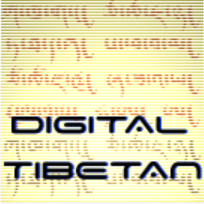Tibetan script and fonts#
Skip history and go directly to the list of available Tibetan fonts.
History of Tibetan script#
While Tibetan script is (remotely) related to Western Latin script via there common ancestor Proto-Sinaitic, the first alphabetic script, the Tibetan language is part of the Sino-Tibetan language family, without common ancestor with Indo-European or Afro-Asiatic languages. The following is a short overview of the relations between different scripts and languages:
Script development#
The following table compares five consonants in different scripts. With exception of Proto-Sinaitic, Gupta, Rañjanā, Lantsa, and Nāgarī (which are images due to not yet being part of Unicode), correct display requires the corresponding Unicode fonts being installed. If fonts are missing (visible as a row in the table just being placeholder-boxes), it’s easiest to install the Noto family of fonts.
Development of Tibetan script#
This table shows the development of consonants b, d, m, r, and t:
Script |
b |
d |
m |
r |
t |
Time period |
|---|---|---|---|---|---|---|
𓉐 |
𓉿 |
𓈖 |
𓁶 |
𓏴 |
c. 3200 BC - AD 400 |
|
1900 BC - 1500 BC |
||||||
𐤁 |
𐤃 |
𐤌 |
𐤓 |
𐤕 |
1050 BC - 150 BC |
|
𐡁 |
𐡃 |
𐡌 |
𐡓 |
𐡕 |
800 BC - AD 600 |
|
𑀩 |
𑀤 |
𑀫 |
𑀭 |
𑀢 |
300 BC - AD 500 |
|
AD 400 - AD 600 |
||||||
𑖤 |
𑖟 |
𑖦 |
𑖨 |
𑖝 |
AD 600 - AD 1200 |
|
AD 1100 - present |
||||||
AD 1100 - present |
||||||
AD 100 (early), AD 700 - present |
||||||
ब |
द |
म |
र |
त |
AD 100 (early) AD 700 - present |
|
བ |
ད |
མ |
ར |
ཏ |
AD 650 - present |
|
ꡎ |
ꡊ |
ꡏ |
ꡘ |
ꡈ |
(vertical script, turn 90° clockwise!) AD 1300 - present |
According to William Woodville Rockhill,[6] Tibetan was developed based on Nāgarī script:
The 7th century Tibetan king Songtsen Gampo ordered that all foreign books be transcribed into Tibetan language, and sent his ambassador Tonmi Sambota to India to acquire alphabet and writing methods, who returned with Sanskrit Nāgarī script from Kashmir corresponding to 24 Tibetan sounds and innovating new symbols for 6 local sounds. Wikipedia
For comparison: development of Latin script#
The common ancestor of all alphabetic system based scripts is Proto-Sinaitic. Additionally, Old Italic was influenced by Phoenician:[7]
Proto-Sinaitic is considered the earliest trace of alphabetic writing and the common ancestor of both the Ancient South Arabian script and the Phoenician alphabet, which led to many modern alphabets including the Greek alphabet.[8]
Script |
b |
d |
m |
r |
t |
Time period |
|---|---|---|---|---|---|---|
𓉐 |
𓉿 |
𓈖 |
𓁶 |
𓏴 |
c. 3200 BC - AD 400 |
|
1900 BC - 1500 BC |
||||||
𐤁 |
𐤃 |
𐤌 |
𐤓 |
𐤕 |
1050 BC - 150 BC |
|
Β |
Δ |
Μ |
Ρ |
Τ |
800 BC - present |
|
𐌁 |
𐌃 |
𐌌 |
𐌓 |
𐌕 |
700 BC - 100 BC |
|
B |
D |
M |
R |
T |
700 BC - present |
|
ᛒ |
ᛞ |
ᛗ |
ᚱ |
ᛏ |
AD 150 - AD 1100 |
Inter-relations#
Open questions#
Note: the relations between Hieroglyphs, Indus script, Proto-Sinaitic, and Cuneiform are subject of active research, and there are different theories on origins and relations between these scripts.
Among current theories are:
Geoffrey Sampson stated that Egyptian hieroglyphs “came into existence a little after Sumerian script, and, probably, [were] invented under the influence of the latter”,[9] and that it is “probable that the general idea of expressing words of a language in writing was brought to Egypt from Sumerian Mesopotamia”.[10][11]
Alternate theories on Tibetan scripts#
According to Ribur Ngawang Gyatso[12], Thonmi Sambota, being sent to India by Srongtsan Gampo to search for a script, upon his return to Tibet, formulated the Tibetan script from Lantsa and Vartu.
Historical evidence however shows that a modified version of the Rañjanā script was adopted as Lantsa for use of creating Sanskrit titles.
Current consensus#
It is however consensus that all alphabetic scripts have Proto-Sinaitic as common ancestor.
graph TD;
BA(<a href='https://en.wikipedia.org/wiki/Megalithic_graffiti_symbols'>Megalithic graffiti symbols</a>)-.->BB(<a href='https://en.wikipedia.org/wiki/Indus_script'>Indus script</a><br><small>3500 BC - 1900 BC<small/>);
CA(<a href='https://en.wikipedia.org/wiki/Linear_Elamite'>Linear Elamite script</a><br><small>3000 BC - 1850 BC</small>)-->CB(<a href='https://en.wikipedia.org/wiki/Elamite_cuneiform'>Cuneiform Elamite</a><br><small>3000 BC - 400 BC</small>);
CB-->CD(<a href='https://en.wikipedia.org/wiki/Cuneiform#Sumero-Akkadian_cuneiform'>Cuneiform Sumerian</a><br><small>2300 BC - 2000 BC</small>);
CD-->CE(<a href='https://en.wikipedia.org/wiki/Cuneiform#Sumero-Akkadian_cuneiform'>Cuneiform Akkadian</a><br><small>2000 BC - 1800 BC</small>);
L0A(<a href='https://en.wikipedia.org/wiki/Egyptian_hieroglyphs'> Egyptian Hieroglyphs</a><br><small>3200 BC - AD 400</small>)-->LA(<a href='https://en.wikipedia.org/wiki/Proto-Sinaitic_script'>Proto-Sinaitic script</a><br><small>1900 BC - 1500 BC</small>);
LA-->LB(<a href='https://en.wikipedia.org/wiki/Phoenician_alphabet'>Phoenician alphabet</a><br><small>1050 BC - 150 BC</small>);
LB-->LC(<a href='https://en.wikipedia.org/wiki/Aramaic_alphabet'>Aramaic alphabet</a><br><small>800 BC - AD 600</small>);
LC-->LD(<a href='https://en.wikipedia.org/wiki/Brahmi_script'>Brāhmī</a><br><small>300 BC - AD 500</small>);
LD-->LE(<a href='https://en.wikipedia.org/wiki/Gupta_script'>Gupta</a><br><small>AD 400 - AD 600</small>);
LE-->LF(<a href='https://en.wikipedia.org/wiki/Siddha%E1%B9%83_script'>Siddhaṃ</a><br><small>AD 600 - AD 1200</small>);
LF-->LF2(<a href='https://en.wikipedia.org/wiki/Nepalese_scripts'>Nepalese</a><br><small>AD 1100 - AD 1950</small>);
LF2-->LF3(<a href='https://en.wikipedia.org/wiki/Ranjana_script'>Rañjanā</a><br><small>AD 1100 - present</small>);
LF3-->LF4(<a href='http://www.lantsha-vartu.org/'>Lantsa, Lanthsa</a><br><small>AD 1100 - present</small>)
LF-->LG(<a href='https://en.wikipedia.org/wiki/N%C4%81gar%C4%AB_script'>Nāgarī</a><br><small>AD 100 early, AD 700 - present</small>);
LG-->LH(<a href='https://en.wikipedia.org/wiki/Devanagari'>Devanagari</a><br><small>AD 100 early AD 700 - present</small>);
LG-->LI;
LH-.->LI(<a href='https://en.wikipedia.org/wiki/Tibetan_script'>Tibetan script</a><br><small>AD 650 - present</small>);
LA-->LK(<a href='https://en.wikipedia.org/wiki/Greek_alphabet'>Greek alphabet</a><br><small>800 BC - present</small>);
LK-->LL(<a href='https://en.wikipedia.org/wiki/Old_Italic_scripts'>Old Italic script</a><br><small>700 BC - 100 BC</small>);
LL-->LM(<a href='https://en.wikipedia.org/wiki/Latin_alphabet'>Latin alphabet</a><br><small>700 BC - present</small>);
LL-->LN(<a href='https://en.wikipedia.org/wiki/Runes'>Runes</a><br><small>AD 150 - AD 1100</small>);
LI-->LI2(<a href='https://en.wikipedia.org/wiki/%CA%BCPhags-pa_script'>Mongolian 'phags pa script</a><br><small>AD 1300 - present</small>)
BB-.->LD;
BB-.->BA;
BB-.->CA;
CA-.->BB;
LB-.->LL;
LE-.->LI;
BB-.->LA;
LA-.->BB;
LI-.->LF4;
Source: compiled from Wikipedia 2022-05
Language development#
graph TD;
AAA[Sino-Tibetan language family]-->AAB[Tibeto-Kanauri];
AAB-->AAC[Bodish];
AAC-->AAD[Tibetic];
AAD-->AAE[Old Tibetan];
AAE-->AAF[Tibetan];
AAA-->AAG[Sinitic];
AAG-->AAH[Chinese];
graph TD;
AA[Indo-European language family]-->AB[Indo-Iranian];
AB-->AC[Indo-Aryan];
AC-->AD[Sanskrit];
AA-->ABA[Germanic];
ABA-->ABB[West Germanic];
ABB-->ABC[High German];
ABC-->ABD[German];
ABB--> ABBA[North Sea Germanic];
ABBA-->ABBB[Anglo-Frisian];
ABBB-->ABBC[Anglic];
ABBC-->ABBD[English];
AA-->ACA[Italo-Celtic?];
ACA-->ACB[Italic];
ACB-->ACC[Romance];
ACC-->ACD[Western Romance];
ACD-->ACE[Gallo-Romance];
ACE-->ACF[Oïl];
ACF-->ACG[French];
graph TD;
AH[Afro-Asiatic language family]-->AI[Semitic];
AI-->AJ[East Semitic];
AJ-->AK[Akkadian];
BE[Sumerian language isolate]<-.->AK;
AI-->AM[Central Semitic];
AM-->AN[Northwest Semitic];
AN-->AO[Aramaic];
AO-->AP[Eastern Aramaic];
AP-->AQ[Northeastern Neo-Aramaic];
AQ-->AR[Assurian];
Sources: compiled from Wikipedia 2022-05

























